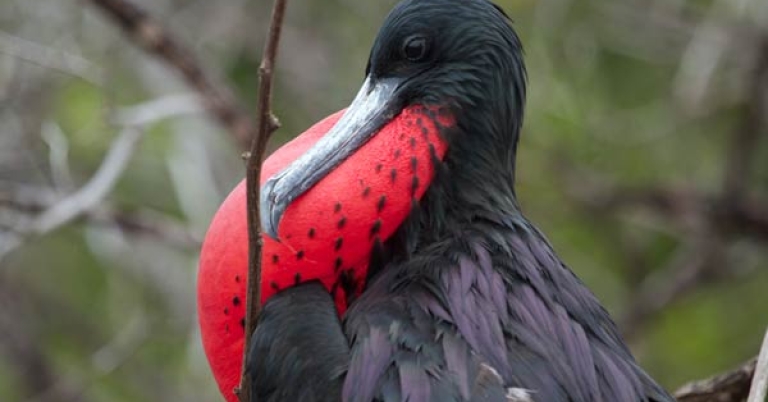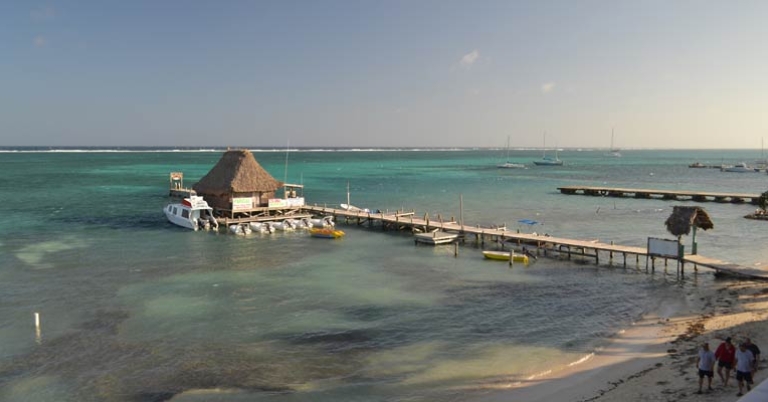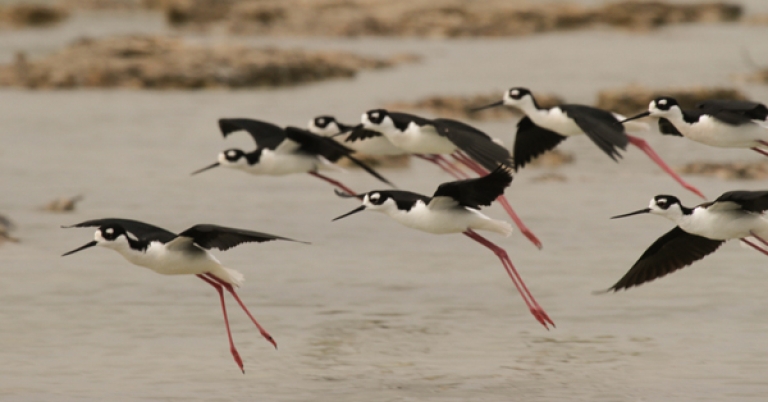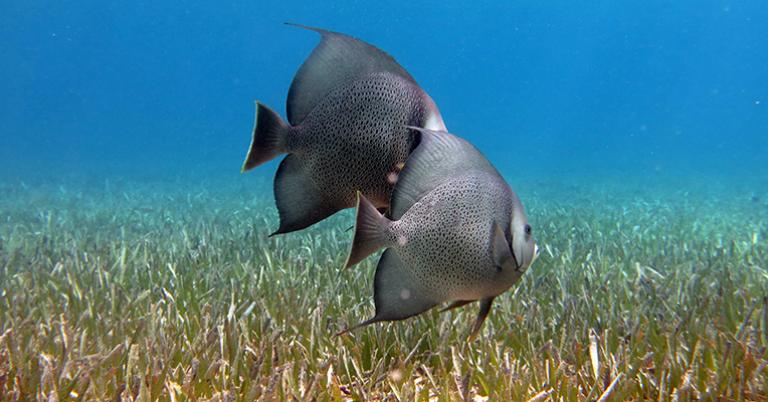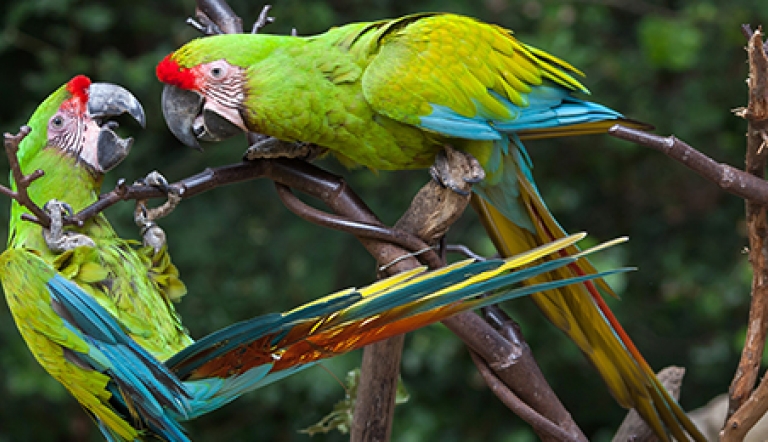About this Trip
Continue your adventure through Belize with this four day post-trip extension to Ambergris Caye.
Highlights
- Embark on a full day trip to Caye Caulker for snorkeling at Hol Chan Marine Reserve and Shark Ray Alley.
- Visit ACES Wildlife Rescue, a non-profit organization dedicated to conserving and protecting the native wildlife of Belize and their critical habitats.
- Accompanied by a local guide, Search for the island's avian species, including Yellow-Bellied Sapsucker, Caribbean Dove, Black-necked Stilt, and more.
About Hawks Aloft
 Hawks Aloft, Inc, a 501-C-3 nonprofit organization based in Albuquerque, New Mexico was founded in 1994 by 12 like-minded individuals with expertise in a wide variety of professional fields. Our vision focuses on protecting indigenous wild birds and their habitats. Our goal was then, and continues to be to act with transparency and collaborate with others to build a network that conducts research on all species of birds and fosters future leaders by providing school-year long education programs free of charge to low income schools. In 2013, we incorporated raptor rescue into our mission in response to overwhelming requests for help with injured birds. Today, we run the New Mexico Raptor Rescue Hotline, a free statewide resource for people who have found an injured bird or have other concerns.
Hawks Aloft, Inc, a 501-C-3 nonprofit organization based in Albuquerque, New Mexico was founded in 1994 by 12 like-minded individuals with expertise in a wide variety of professional fields. Our vision focuses on protecting indigenous wild birds and their habitats. Our goal was then, and continues to be to act with transparency and collaborate with others to build a network that conducts research on all species of birds and fosters future leaders by providing school-year long education programs free of charge to low income schools. In 2013, we incorporated raptor rescue into our mission in response to overwhelming requests for help with injured birds. Today, we run the New Mexico Raptor Rescue Hotline, a free statewide resource for people who have found an injured bird or have other concerns.
We are proud to partner with Holbrook Travel to be able to offer our members and others the opportunity to travel, see native wildlife in other lands, experience differing cultures, and learn from local conservationists about efforts in their countries. https://hawksaloft.org
About your leader
 Gail Garber
Gail Garber
Gail Garber, Executive Director, discovered her passion for birds over 30 years ago. She has dedicated her life to avian studies, education, and other aspects of Hawks Aloft, and has traveled much of the U.S. as well as Canada, Venezuela, Honduras, United Arab Emirates, Kenya, Tanzania, Italy, France, and Switzerland. She has led birding tours to New Zealand, Ecuador, Costa Rica, Peru, and Guatemala. Garber is a popular speaker for adult programs at birding festivals in New Mexico and Colorado where she regularly leads raptor tours, sharing her love of birding and conservation. As an artist, writer, and executive director of Hawks Aloft, Gail has written three books and published numerous articles in many fields. In her other life, she is a professional quilt maker (Gail Garber Designs) and often travels to teach and lecture on methods that she has developed. Much of her leisure time is spent outdoors, often in the company of her two beloved dogs, Martial and Harpy.
What makes us different
Scopes
Wildlife up-close
Cultural Discovery
Meaningful experiences
Expert guides
Service anytime
Daily Itinerary
Print ItineraryAmbergris Caye
Ambergris Caye
Ambergris Caye
Departure
Pricing
Print PricingWhat's Included
- Activities and meals as mentioned in itinerary
- Internal flights relevant to itinerary
- Local guide during tours only
- Private transportation for tours and transfers
- Water during meals
What's Not Included
- Items of personal nature
- Tips
- Travel Insurance
Travel Info
Print Travel InfoEntry & Exit Requirements
U.S. citizens must have a valid passport to enter Belize. U.S. passports must be valid for the duration of your stay in Belize. As this requirement is subject to change at any time without notice, we recommend at least six months’ passport validity.
A visa is not required for visits up to 30 days.
If you are not traveling with a U.S. passport, please check with the Belizean Embassy for the requirements based on your nationality.
When leaving Belize by air, there is a departure tax of USD $55.50, which is usually included in the cost of your airfare. Consult with your airline to determine whether the departure tax is included in your ticket cost. If the departure tax is not included in your ticket cost, it should be paid at the airport prior to check-in, payable in cash only (U.S. currency).
Health Information
IMMUNIZATIONS
The Centers for Disease Control recommends that all travelers be up to date on routine vaccinations such as measles-mumps-rubella (MMR) vaccine, diphtheria-pertussis-tetanus vaccine, varicella (chicken pox) vaccine, and your yearly flu shot, as well as COVID-19 vaccination, before every trip.
There are no vaccinations required for entry into Belize, unless you are traveling from (or transiting through) a country where yellow fever transmission is a risk, in which case proof of yellow fever vaccination is required.
Though not required for entry, the CDC recommends vaccination against hepatitis A, hepatitis B, and typhoid for most unvaccinated travelers visiting Belize.
Please consult your physician for additional information and recommendations based on your individual circumstances.
MALARIA
Malaria is caused by a parasite found in Anopheles mosquitos, which are active from dusk until dawn. The CDC advises that the risk of malaria in Belize is low, but travelers should still take precautions against mosquito bites. To protect against mosquitos, the CDC recommends that you cover exposed skin with lightweight, long-sleeved shirts and pants, consider treating clothes with permethrin, and use an insect repellent containing an EPA-registered active ingredient like DEET, picaridin, or oil of lemon eucalyptus (OLE). Apply sunscreen first, followed by the repellent, ideally 20 minutes later.
Be careful when applying products containing DEET, as it can damage or dissolve certain synthetic fabrics as well as plastic, rubber, vinyl, or elastic materials, such as those used in camera equipment, binoculars, phone cases, sunglasses, or watches. Additionally, some research suggests that when DEET and picaridin enter local waterways, they can be harmful to amphibians and other wildlife. When selecting a repellent, it is ultimately up to each traveler to weigh the risks and benefits of different options, keeping in mind both environmental factors and the importance of protecting against illness.
DENGUE FEVER AND OTHER INSECT-BORNE ILLNESSES
Other insect-borne illnesses are known to occur in Belize, including dengue fever, leishmaniasis, Zika virus, and others. Travelers to Belize should protect themselves against insect bites using the measures described above.
After spending time outdoors in grassy or wooded areas, the CDC recommends showering and conducting a full-body check for ticks. If you find a tick attached to your skin, safely remove it as soon as possible.
As a precaution, the CDC advises women who are pregnant to consider postponing travel to any area where Zika virus transmission is ongoing.
OTHER NUISANCE PESTS
In places with rich vegetation and proximity to bodies of water, you may encounter chiggers. These are mites that can superficially attach to skin and leave behind itchy red bumps that appear 3-6 hours after initial contact. Their bites are sometimes mistaken for those of bed bugs or other insects; however, unlike bed bugs, which tend to target exposed skin, chiggers look for skin folds or areas where clothing fits tightly—like the ankles, waist, underarms, elbow creases, and the back of the knees—to feed on broken-down skin cells. They are not known to transmit any illnesses in Belize but can cause considerable discomfort.
We recommend that travelers protect themselves against chigger bites using the measures noted above. Additionally, if potential exposure occurs, we recommend showering and scrubbing skin with soap and hot water as quickly as possible. If that is not immediately feasible, promptly rub skin with a dry towel or cloth and place any exposed clothing in a zip-top bag until it can be washed. To treat any itchiness, we suggest over-the-counter anti-itch lotion and/or oral antihistamines.
SUN EXPOSURE
The effects of the sun can be damaging to the eyes and skin. Spending time outdoors exposes you to the sun’s harmful ultraviolet (UV) rays, even on cloudy days. To protect yourself from the sun, use a broad spectrum sunscreen of at least SPF 15, protect skin with clothing, wear a wide-brimmed hat and sunglasses, and drink plenty of fluids.
Respiratory Illness Protocols
Please review our Respiratory Illness Protocols page, which explains our policy and procedures if you or another traveler should develop symptoms of a respiratory illness during your trip. Your participation in a Holbrook Travel program indicates that you are in agreement with these protocols.
Liability Waivers
Please note you may be asked locally to sign liability waivers in order to participate in certain activities. If you would like to receive a copy of any required waiver in advance, please contact Holbrook Travel.
Resources
Print ResourcesPacking Recommendations
Everyone has personal preferences when it comes to packing; for this reason, the information below is offered as a general guide and not a definitive list. You know yourself best: Use your discretion and pack what you think will serve you, based on your personal preferences and specific itinerary.
You may find many of the items below in our Gear Store.
CLOTHING
Casual, comfortable clothing is suitable for most activities in Belize. You may wish to bring a slightly nicer outfit or two (eg sundress, polo shirt) if your itinerary includes dinners out or more formal activities.
Bring enough clothing suitable for the length of your program. If you prefer to pack light, note that many hotels offer laundry services at additional cost. If you plan to hand-wash items, remember that humidity may delay drying time.
Pack clothing that can be worn in layers to adapt to weather changes throughout the day. Belize’s rainy season is June to November, but it can rain at any time. Clothing that wicks away moisture and dries quickly is recommended.
- A combination of short-sleeved and lightweight, long-sleeved shirts for sun and insect protection
- Shorts
- Lightweight, quick-drying long pants for sun and insect protection
- Undergarments
- Sleepwear
- Lightweight jacket or sweater/sweatshirt
- 1-2 bathing suit(s) for the beach, if applicable, plus many hotels have pools
- Socks – Bring extra pairs. If your itinerary indicates muddy hikes with rubber boots provided on-site, pack a few pairs of knee socks to prevent blisters.
- Shoes – Consider your specific itinerary when choosing footwear. For most programs, you’ll likely want at least one pair of comfortable, closed-toe walking or hiking shoes suitable for forest hikes and walking over cobblestones or other uneven terrain. Sturdier hiking boots may be appropriate for more active itineraries. In addition, many participants opt for a pair of sturdy sport-strap sandals (e.g. Keens, Tevas, or similar) and/or casual flip-flops or sandals. If you’re caving or visiting the beach or cayes, you may also want a pair of aqua socks, reef walkers, or water shoes.
- Lightweight rain jacket, hooded poncho, and/or windbreaker
- Visor or wide-brimmed sun hat
- Bandana, scarf, or neck gaiter
Personal Toiletries
Pack toiletries based on your personal preferences and habits. Below are just a few recommendations to keep in mind.
Note that COVID self-test kits are not legal in Belize and may be confiscated at the airport.
- Shampoo, conditioner, lotion, deodorant/antiperspirant , etc. – If possible, avoid strong fragrances if you are sensitive to insect bites and to be considerate of your fellow travelers.
- Soap and washcloth or a small, quick-drying microfiber towel – Washcloths are not standard in all hotels. If you normally use a washcloth, you may wish to bring one from home.
- Hairbrush, comb, hair ties, shower cap
- Toothbrush and toothpaste
- Razor
- Ear plugs, especially if you are a light sleeper
- Personal hygiene products
- Insect repellent with DEET or picaridin (see note below about treating clothing with permethrin)
- Sunscreen and lip balm with SPF – If you’ll be in the ocean, biodegradable/reef-safe sunscreen with a mineral-based active ingredient like zinc oxide or titanium oxide is required.
- Aloe vera gel
- A travel pack of tissues – also useful as napkins or toilet paper if needed
In addition to your personal toiletries, it is useful to pack a small medical kit, which you can easily prepare. Helpful items might include: bandages, antihistamine, a pain reliever, motion sickness and/or altitude sickness medication (if you are prone to either), anti-diarrhea medicine, individually wrapped pre-moistened towelettes and/or hand sanitizer, antibiotic ointment, anti-fungal cream, moleskin for blisters, eye drops, tweezers, a mini sewing kit, and an extra pair of disposable contact lenses or eyeglasses if you wear them.
Days before you leave home, you may wish to consider spraying any clothing, socks, and shoes that will be worn in lowland, tropical sites with permethrin, an anti-parasite medication, to repel irritating pests and prevent the spread of disease. A recommended brand is Sawyer. Carefully read all instructions before use. Please note permethrin is highly toxic to cats and fish, and some aerosol products may be harmful to birds. Side effects may include minor itching, burning, or redness. You may want to use a laundry marker to label and keep track of which socks are permethrinized. Only one application per item is necessary; permethrin on treated clothes remains effective through several washings. Permethrin should NOT be applied directly to skin.
Miscellaneous
Remember to pack valuables such as your passport, cash/credit cards, and medications in your carry-on luggage.
- Passport and photocopies of all travel documentation
- Personal insurance card and travel insurance information
- Money – ATM/credit card and/or cash; small bills in good condition are recommended
- Prescription medicines (if applicable), with a copy of the prescription
- Yellow fever certificate (if required; only if arriving from a country where yellow fever transmission is a risk)
- Sunglasses with strap
- Small day pack for hikes and excursions
- Flashlight and/or head lamp
- Travel alarm clock or inexpensive waterproof wristwatch with alarm – Not all hotels provide alarm clocks.
- A pocket calculator or phone to assist with conversions and currency exchange
- Binoculars with lens cleaner
- Camera and related equipment, such as charger, lenses, and extra memory cards
- Reusable water bottle
- Non-perishable snacks; electrolyte powder packets
- Pocket-knife or multipurpose tool – Pack in your checked luggage
- Zip-top style bags – useful for packing toiletries, sorting clothing, storing damp or muddy shoes, or as a dry bag for protecting electronics
- Notepad or travel journal and pen
- Music or reading material for down time, long bus drives, or on the airplane, and a portable bright light to read by
- Collapsible walking stick with rubber tip
- A small quantity of laundry detergent if you’ll be washing clothing by hand
- Travel-size umbrella – Some people find this unwieldy to carry, while others find it offers better protection than a rain jacket alone.
- Money belt
- Converter/adapter
- Chargers for electronics

Questions
Contact Sandy Schmidt at 877-907-5360 or email Sandy.





